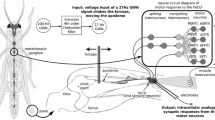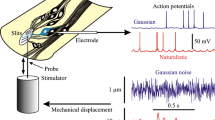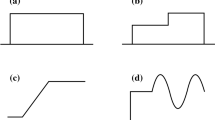Abstract
This paper continues the investigation of a three-loop representation of the segmental muscle stretch reflex system introduced in a preceding communication. Frequency response characteristics were computed for open-loop conditions, control and disturbance signal inputs under a variety of conditions: (i) “in parallel” and “in series” peripheral arrangements of muscle compartments, (ii) various patterns of central connectivity, (iii) various recruitment levels of motor units, (iv) various overall reflex gains, (v) absence or presence of muscle spindle accleration sensitivity. These computations disclosed a number of mechanisms by which the nervous system might improve system stability and behaviour. These mechanisms are discussed with regard to physiological data.
Similar content being viewed by others
References
Allum, J.H.J., Dietz, V., Freund, H.J.: Neuronal mechanisms underlying physiological tremor. J. Neurophysiol.41, 557–571 (1978)
Appelberg, B., Jeneskog, T.: Mesencephalic fusimotor control. Exp. Brain Res.15, 97–112 (1972)
Appelberg, B., Jeneskog, T., Johansson, H.: Rubrospinal control of static and dynamic fusimotor neurones. Acta physiol. Scand.95, 431–440 (1975)
Appenteng, K., O'Donovan, M.J., Somjen, G., Stephens, J.A., Taylor, A.: The projection of jaw elevator muscle spindle afferents to fifth nerve motoneurones in the cat. J. Physiol. (London)279, 409–423 (1978)
Burke, D., Hagbarth, K.-E., Skuse, N.F.: Recruitment order of human spindle endings in isometric voluntary contractions. J. Physiol. (London)285, 101–112 (1978)
Burke, D., McKean, B., Westerman, R.A.: Induced changes in the thresholds for voluntary activation of human spindle endings. J. Physiol. (London)302, 171–181 (1980)
Cussons, P.D., Matthews, P.B.C., Muir, R.B.: Enhancement by agonist or antagonist muscle vibration of tremor at the elastically loaded human elbow. J. Physiol. (London)302, 443–461 (1980)
Dufresne, J.R., Soechting, J.F., Terzuolo, C.A.: Electromyographic response to pseudorandom torque disturbances of human forearm position. Neurosci.3, 1213–1226 (1978)
Dufresne, J.B., Soechting, J.F., Terzuolo, C.A.: Reflex motor output to torque pulses in man: identification of short- and long-latency loops with individual feedback parameters. Neurosci.4, 1493–1500 (1979)
Dufresne, J.R., Soechting, J.F., Terzuolo, C.A.: Modulation of the myotatic reflex gain in man during intentional movements. Brain Res.193, 67–84 (1980)
Elble, R.J., Randall, J.E.: Motor-unit activity responsible for 8- to 12-Hz component of human physiological finger tremor. J. Neurophysiol.39, 370–383 (1976)
Emonet-Dénand, F., Jami, L., Laporte, Y.: Histophysiological observations on the skeleto-fusimotor innervation of mammalian spindles. In: Spinal and supraspinal mechanisms of voluntary motor control and locomotion. Desmedt, J.E. (ed.), pp 1–11 (Progress in clinical neurophysiology, Vol. 8). Basel: Karger 1980
Goodwin, G.M., Hoffman, D., Luschei, E.: The strength of the reflex response to sinusoidal stretch of monkey jaw closing muscles during voluntary contraction. J. Physiol. (London)279, 81–111 (1978)
Gottlieb, G.L., Agarwal, G.C.: Response to sudden torques about ankle in man: myotatic reflex, J. Neurophysiol.42, 91–106 (1979)
Hasan, Z., Houk, J.C.: Transition in sensitivity of spindle receptors that occurs when muscle is stretched more than a fraction of a millimeter. J. Neurophysiol.38, 673–689 (1975)
Henneman, E.: Organization of the motoneuron pool: the size principle. In: Medical physiology. Mountcastle, V.B. (ed.), pp. 718–741. Vol. 1. St. Louis: Mosby 1980
Hultborn, H., Lindström, S., Wigström, H.: On the function of recurrent inhibition in the spinal cord. Exp. Brain Res.37, 399–403 (1979)
Hultborn, H., Pierrot-Deseilligny, E.: Changes in recurrent inhibition during voluntary soleus contractions in man studied by theH-reflex technique. J. Physiol. (London)297, 229–251 (1979)
Hunt, C.C., Wilkinson, R.S.: An analysis of receptor potential and tension of isolated cat muscle spindles in response to sinusoidal stretch. J. Physiol. (London)302, 241–262 (1980)
Jami, L., Murthy, K.S.K., Petit, J.: Proportion of skeletofusimotor axons (β axons) in the motor supply to the cat peroneus tertius muscle. Neurosci. Lett., Suppl.5, 225 (1980)
Joyce, G.C., Rack, P.M.H.: The effects of load and force on tremor at the elbow joint. J. Physiol. (London)240, 375–396 (1974)
Joyce, G.C., Rack, P.M.H., Ross, H.F.: The forces generated at the human elbow joint in response to imposed sinusoidal movements of the forearm. J. Physiol. (London)240, 351–374 (1974)
Koehler, W., Windhorst, U.: Multi-loop representation of the segmental muscle stretch reflex. Its risk of instability. Biol. Cybern.38, 51–61 (1980)
Koehler, W., Windhorst, U., Schmidt, J., Meyer-Lohmann, J., Henatsch, H.-D.: Diverging influences on Renshaw cell responses and monosynaptic reflexes from stimulation of capsula interna. Neurosci. Lett.8, 35–39 (1978)
Lippold, O.C.J.: Oscillation in the stretch reflex arc and the origin of the rhythmical, 8-12 c/s component of physiological tremor. J. Physiol. (London)206, 359–382 (1970)
Loeb, G.E., Duysens, J.: Activity patterns in individual hindlimb primary and secondary muscle spindle afferents during normal movements in unrestrained cats. J. Neurophysiol.42, 420–440 (1979)
Lundberg, A.: Control of spinal mechanisms from the brain. In: The basic neurosciences. Brady, R.O. (ed.), pp. 253–265 (The nervous system, Vol. 1). New York: Raven Press 1975
Marsden, C.D., Merton, P.A., Morton, H.B.: Servo action in human voluntary movement. Nature238, 140–143 (1972)
Matthews, P.B.C., Muir, R.B.: Comparison of electromyogram spectra with force spectra during human elbow tremor. J. Physiol. (London)302, 427–441 (1980)
Matthews, P.B.C., Stein, R.B.: The sensitivity of muscle spindle afferents to small sinusoidal changes of length. J. Physiol. (London)200, 723–743 (1969)
Neilson, P.D., Lance, J.W.: Reflex transmission characteristics during voluntary activity in norman man and patients with movement disorders. In: Cerebral motor control in man: long loop mechanisms. Desmedt, J.E. (ed.), pp 263–299 (Progress in clinical neurophysiology, Vol. 4). Basel: Karger 1978
Nelson, S.G., Collatos, T.C., Niechaj, A., Mendell, L.M.: Immediate increase in Ia-motoneuron synaptic transmission caudal to spinal cord transsection. J. Neurophysiol.42, 655–664 (1979)
Oğuztöreli, M.N., Stein, R.B.: The effects of multiple reflex pathways on the oscillations in neuro-muscular systems. J. Math. Biol.3, 87–101 (1976)
Poppele, R.E., Terzuolo, C.A.: Myotatic reflex: its input-output relation. Science159, 743–745 (1968)
Poppele, R.E., Bowman, R.J.: Quantitative description of linear behavior of mammalian muscle spindles. J. Neurophysiol.33, 59–72 (1970)
Prochazka, A., Stephens, J.A., Wand, P.: Muscle spindle discharge in normal and obstructed movements. J. Physiol. (London)287, 57–66 (1979)
Rosenthal, N.P., McKean, T.A., Roberts, W.J., Terzuolo, C.A.: Frequency analysis of stretch reflex and its main subsystems in triceps surae muscles of the cat. J. Neurophysiol.33, 713–749 (1970)
Schwarz, H.: Frequenzgang- und Wurzelortskurvenverfahren. Mannheim: Bibliographisches Institut 1968
Starkermann, R.: Mehrgrößen-Regelsysteme. I. Zürich: Bibliographisches Institut 1974
Stein, R.B.: Peripheral control of movement. Physiol. Rev.54, 215–243 (1974)
Stein, R.B., Oğuztöreli, M.N.: Tremor and other oscillations in neuromuscular systems. Biol. Cybern.22, 147–158 (1976a)
Stein, R.B., Oğuztöreli, M.N.: Does the velocity sensitivity of muscle spindles stabilize the stretch reflex? Biol. Cybern.23, 219–228 (1976b)
Stein, R.B., Oğuztöreli, M.N.: Reflex involvement in the generation and control of tremor and clonus. In: Physiological tremor, pathological tremors, and clonus. Desmedt, J.E. (ed.), pp. 28–50 (Progress in clinical neurophysiology, Vol. 5). Basel: Karger 1978
Stiles, R.N.: Frequency and displacement, amplitude relations for normal hand tremor. J. Appl. Physiol.40, 44–54 (1976)
Stiles, R.N.: Mechanical and neural feedback factors in postural hand tremor of normal subjects. J. Neurophysiol.44, 40–59 (1980)
Taylor, A.: The significance of grouping of motor unit activity. J. Physiol. (London)162, 259–269 (1962)
Taylor, A.: Fibre types in the muscles of mastication. In: Mastication. Anderson, D.J., Matthews, B. (eds.), pp. 16–24. Wright: Bristol 1976
Vallbo, Å.B., Hulliger, M.: Flexible balance between skeletomotor and fusimotor activity, during voluntary movements in man. Neurosci. Lett., Suppl.3, 103 (1979)
Vilis, T., Hore, J.: Central neural mechanisms contributing to cerebellar tremor produced by limb perturbations. J. Neurophysiol.43, 279–291 (1980)
Windhorst, U.: Auxiliary spinal networks for signal focussing in the segmental stretch reflex system. Biol. Cybern.34, 125–135 (1979a)
Windhorst, U.: A possible partitioning of segmental muscle stretch reflex into incompletely de-coupled parallel loops. Biol. Cybern.34, 205–213 (1979b)
Yap, C.B., Boshes, B.: The frequency and pattern of normal tremor. Electroenceph. Clin. Neurophysiol.22, 197–203 (1967)
Author information
Authors and Affiliations
Rights and permissions
About this article
Cite this article
Koehler, W., Windhorst, U. Frequency response characteristics of a multi-loop representation of the segmental muscle stretch reflex. Biol. Cybernetics 40, 59–70 (1981). https://doi.org/10.1007/BF00326681
Received:
Issue Date:
DOI: https://doi.org/10.1007/BF00326681




